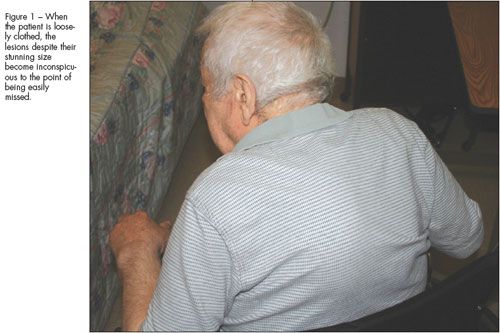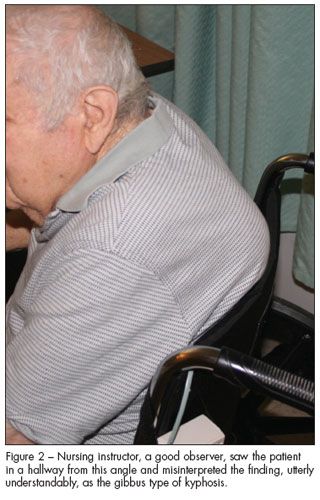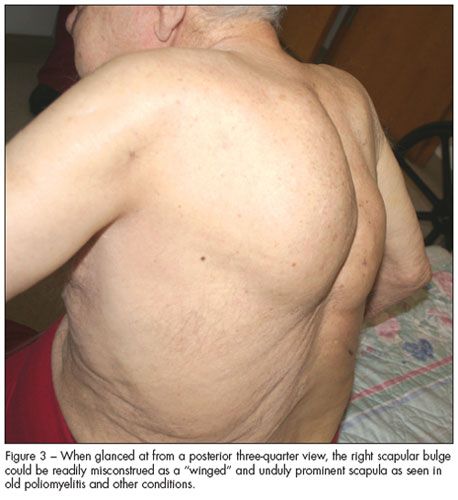Breast-Size Paired Bumps on the Back of an Old Man
A 93-year-old man with known Alzheimer dementia has his admission physical examination on transfer to a geropsychiatric hospital unit due to behavioral difficulties. A language barrier and his stoicism minimize communication, but his devoted wife translates and recounts that he is not in any physical discomfort. Has sometimes needed oxygen treatment in the past.
This article was originally presented as an independent educational activity under the direction of CME LLC. The ability to receive CME credits has expired. The article is now presented here for your reference. CME LLC is no longer responsible for the presentation of the article.
HISTORY

A 93-year-old man with known Alzheimer dementia has his admission physical examination on transfer to a geropsychiatric hospital unit due to behavioral difficulties. A language barrier and his stoicism minimize communication, but his devoted wife translates and recounts that he is not in any physical discomfort. Has sometimes needed oxygen treatment in the past.
PHYSICAL EXAMINATION
Somewhat overweight man who appears a few years younger than stated age, affable but usually silent although he understands more English than he lets on. Breath sounds normal. Range of motion of upper limbs mildly reduced to a degree typical for age. Two hemispheric bumps on back feel utterly soft. Neither is fixed to overlying skin nor to chest wall. Small vertically aligned area of firmer tissue abuts medial margin of left-sided mass. No bruit audible over either. Bumps are distinct from scapulae, which move normally.
What's Your Diagnosis? (Answer on next page)
Answer: Giant Lipomas
These immense masses, covered by intact and normal overlying skin, are readily diagnosable at bedside as lipomas. On palpation, they had the texture of a bag of water because the neutral fat of which they are composed is semi-liquid at body temperature. One did not even look hard for a pore as a possible indicator of an epidermal inclusion cyst (sebaceous cyst, wen), because the texture was so characteristic of lipoma.
The masses also felt exactly like normal breasts of women who are decades past menopause and have not received exogenous estrogen. In such patients atrophy of lobular, ductal, and stromal elements results over many years in breast tissue that is predominantly, almost exclusively, made up of adipocytes. The visual resemblance to pendulous breasts-which one might regard as ridiculous given the gender of the patient and the locale on the back of the thorax rather than the front, not to mention the absence of nipple-areolar complexes and the diagonal rather than horizontal comparative orientation-actually carried meaning: It reminded us to look for sweat retention and intertriginous mycotic dermatitis on the undersides and in the skin fold beneath. Our patient had neither.
An incidental finding is the enlargement of what looks like the left olecranon bursa; in fact this area was multilobulated and firm, and there was a mate to it anteriorly. We diagnosed old gouty tophi and excluded both xanthomas and olecranon bursitis based on locale and characteristics.
COULD THOSE HUGE THINGS BE SARCOMAS?
Even before reading that most liposarcomas arise from deep locations, not from subcutaneous lipomas,1-4 we had low suspicion of cancer. We interpreted the firmer areas, especially because of their location at the (internally indistinct) edge of the lesions, as adjacent trapezius or paraspinal muscles that were somewhat compressed by their large benign neighboring structure. The normality of the skin was consistent with an innocent nature but not confirmatory. While bruits are neither sensitive nor specific markers of cancer, let alone liposarcoma, we were also pleased to find this particular search for trouble came up negative.
The epidemiology offers help: liposarcoma is not a lesion often seen in extreme old age. We took more skeptically the wife’s reassurance that the lesions had not changed for years. Many patients so assert either because they are unaware of slow growth, or to deflect attention and so escape procedures, or even-through magical thinking-the threatening prospect of a malignant diagnosis.
WHAT MAKES THEM GIANT LIPOMAS?
An extensive literature describes giant lipomas in a host of subcutaneous locales5-9 and internally. No consensus exists on what size defines this variant. The smallest tumor we have seen so labeled had a maximal dimension of 10 cm. So both of this patient’s masses far exceed the threshold. Others in numerous reports are still bigger.8
Perhaps this subtype is well known because even if, say, only 1% of any histological type of soft-tissue neoplasm attains such size, so many lipomas arise that even a tiny subset eventually constitutes a well-known entity. We have seen no convincing reports that locale, genetics with the known frequent rearrangements of chromosome 12,1-4 or demographics distinguish giant lipomas from smaller ones. Counterintuitively, we find no evidence that large size predisposes to being malignant, ie a sarcoma.
THE MISTAKE OF NON-EXPOSURE

A common critique nowadays is that many physical examinations are performed cursorily, without taking the trouble to have the patient disrobe-sometimes with the misguided excuse that one is respecting modesty. This patient illustrates the point superbly: one could miss these enormous masses altogether if one relied on looking at his loosely clad back (Figure 1). Had they been cancers of whatever type, such an oversight could constitute a tragically lost chance to diagnose early and to treat with more success and less disfigurement.

How easily one might take the distortion as mere kyphosis. This very morning-this column has the shortest latency between photograph and publication of any to date-that concern came through vividly: nursing students were present on rotation on the unit. I mentioned to their experienced and astute instructor that she might want to have them see my patient’s large lipomas. She heard the name and said, “I saw him in the dining room and had thought he had osteoporosis with excess kyphosis” (Figure 2). So with no criticism-for the occasion for her to examine had not arisen-this colleague underscores my point.
Lest report of examinations without exposure strike any reader as hyperbolic, I sadly recount that though I am well known in my own practice sites for holding self and trainees to careful procedure, I note auscultation through clothing by physicians only too frequently-and decry it and educate the offender each time. Listening over clothing creates artifactual sound and obscures real, diagnostically important sound. Parallel arguments against palpation under clothing and the meaningless sham of inspection achieved through clothing or undergarments hardly require reiteration. A large set of observations (not by myself) in a university hospital some years ago showed more than half the cardiac and pulmonary auscultations were performed through clothing. The data were never published because they would have brought discredit to the institution.
MISCONSTRUALS

It is hard enough to draw accurate conclusions even when examination is performed correctly. In this instance, one could mistake the bulges for serratus anterior palsy with winged scapula (Figure 3).10 The minute one touched the soft and yielding masses, any such thought would evaporate even before one had seen and felt the ordinary non-winged scapula beneath.

One could infer, even with the patient exposed, that this was merely osteoporotic kyphosis or a tuberculous gibbus deformity from old Pott disease, with or without an element of scoliosis that rendered it asymmetrical.11,12 An examiner who observed only from an angle would be much more prone to this diagnostic error (Figure 4). The view from right behind the patient leaves no such opportunity for a mistake. Even had one formed the wrong hypothesis from inspection, palpation would rectify the impression instantly.
WHAT TO DO ABOUT IT
Given this man’s age and comorbidities, imaging as well as consultation and possible operation are unacceptably intrusive to all parties: himself, his wife, his grown children, his physician, and the nursing staff. Even in a younger person, the odds of sarcoma are so slight13 that preventive resection is not routinely advocated in ordinary lipomas. In giant ones, there is a countercurrent,6 but the authors even of that study tried liposuction for therapy in one case, a procedure not utilized for suspected cancer. Superficial locale makes simple removal a shorter and easier procedure than for anything inside fascial planes, let alone within a body cavity.
Were there chronic abrasion, one might make the case for removal as a factor for comfort. Some nonsurgical treatment modalities have been employed in smaller lipomas13 and could also be considered were there a need to take action.
Even though they can recur locally, many low-grade liposarcomas do not produce distant metastases, and in recognition of this and to avoid a hurtful label, many of these are now designated as “atypical lipomas”1-4,14; this nomenclature cor-responds to the wisdom of a generically conservative approach. This biological behavior recalls basal cell carcinoma of the skin, which reminds us that close surveillance is needed. Imaging often distinguishes liposarcoma from lipoma.3 Suspected liposarcoma calls for consultation; if the surgeon removes the lump in question, diagnostic uncertainty evaporates and often even if malignancy is established, cure is achieved with the single procedure.
PRESENTATION IS ALL
It’s well known that the same case can be presented by a skilled resident in 2 ways so as to suggest 2 entirely different diagnoses (eg, “This man with long-standing hypertension is seen for acute interscapular chest pain . . .” versus “This man who somatizes a great deal is seen because of a twisting ache on the back . . .”).
I thought of deliberately misleading by showing as a first image, this man clothed and with oxygen tubing in place: he has sometimes needed oxygen to maintain saturation, because of heart failure. With such a photograph a misinference of restrictive lung disease due to kyphotic chest wall deformity would be likely. But I decided such a deceit could feel disrespectful toward my colleagues who read these columns, however educational the intent. One cannot but realize that the daily practice of medicine throws enough false leads and curveballs. I needn’t be the source of yet another.
References:
REFERENCES:
1
. Mentzel T, Fletcher CD. Lipomatous tumours of soft tissues: an update.
Virchows Arch
. 1995;427:353-363.
2
. Weiss SW. Lipomatous tumors.
Monogr Pathol
. 1996;38:207-239.
3
. Murphey MD, Carroll JF, Flemming DJ, et al. From the archives of the AFIP:benign musculoskeletal lipomatous lesions.
Radiographics.
2004;24:1433-1466.
4
. Dei Tos AP. Liposarcoma: new entities and evolving concepts.
Ann DiagnPathol
. 2000;4:252-266.
5
. Yakubu AA, Edino ST, Mohammed AZ, et al. Giant and complicated subcutaneouslipoma of the neck.
West Afr J Med
. 2008;27:44-46.
6
. Silistreli OK, Durmu EU, Ulusal BG, et al. What should be the treatmentmodality in giant cutaneous lipomas? Review of the literature and report of4 cases.
Br J Plast Surg.
2005;58:394-398.
7
. Di Benedetto G, Aquinati A, Astolfi M, Bertani A. Giant compressing lipomaof the thigh.
Plast Reconstr Surg.
2004;114:1983-1985.
8
. Ozpolat B, Ozeren M, Akkaya T, Yucel E. Giant lipoma of chest wall.
Eur JCardiothorac Surg.
2004;26:437.
9
. Terzioglu A, Tuncali D, Yuksel A, et al. Giant lipomas: a series of 12 consecutivecases and a giant liposarcoma of the thigh.
Dermatol Surg.
2004;30:463-467.
10
. Schneiderman H. Long thoracic nerve stretch injury.
Consultant.
1989;29(10):61-62.
11
. Schneiderman H. Scoliosis in the aged.
Consultant.
2003;43:1581-1585.
12
. Schneiderman H, Bellantonio S. Kyphosis due to osteoporotic compressionfractures of thoracic vertebrae.
Consultant.
1996;36:507-509.
13
. Salam GA. Lipoma excision.
Am Fam Physician.
2002;65:901-904.
14
. Laurino L, Furlanetto A, Orvieto E, Del Tos AP. Well-differentiated liposarcoma(atypical lipomatous tumors).
Semin Diagn Pathol
. 2001;18:258-262.